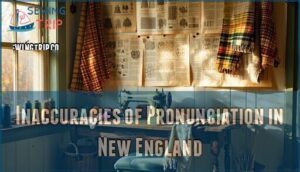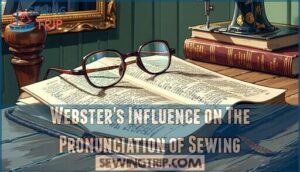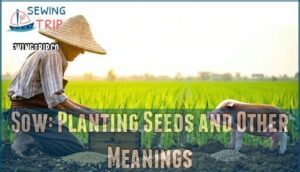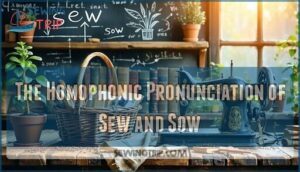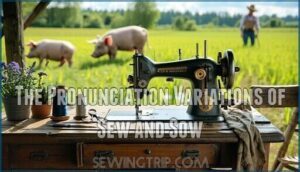This site is supported by our readers. We may earn a commission, at no cost to you, if you purchase through links.
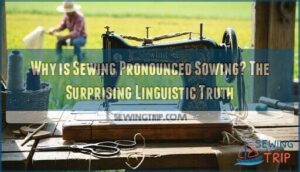 You might wonder why "sewing" sounds like "sowing" when you’re stitching fabric, not planting seeds.
You might wonder why "sewing" sounds like "sowing" when you’re stitching fabric, not planting seeds.
The answer lies in centuries of linguistic evolution and regional pronunciation patterns. Both words developed similar sounds through natural language changes, creating what linguists call homophones—words that sound identical but have different meanings and spellings.
In Old English, "sewing" was pronounced differently, but over time, various dialects and regional accents shifted the pronunciation to match "sowing." Webster’s dictionary later standardized this pronunciation, cementing the similarity we hear today.
This linguistic quirk often confuses writers who mix up "reap what you sow" with "sew." Understanding the historical forces behind these pronunciation shifts reveals fascinating patterns in how English evolved.
Table Of Contents
- Key Takeaways
- The Historical Pronunciation Shift of Sewing to Sowing
- Inaccuracies of Pronunciation in New England
- Webster’s Influence on The Pronunciation of Sewing
- Meanings of Sew and Sow
- The Homophonic Pronunciation of Sew and Sow
- Distinction Between Sew and Sow in Past Tense and Past Participle Forms
- Sow Vs. So: Differentiating The Pronunciations and Meanings
- The Trick to Remembering The Difference Between Sew and Sow
- The Pronunciation Variations of Sew and Sow
- The Complexity of Language Evolution and Communication
- Frequently Asked Questions (FAQs)
- Conclusion
Key Takeaways
- You’ll find that "sewing" and "sowing" weren’t always pronounced the same – centuries of regional dialect changes and natural language evolution gradually merged their sounds into identical pronunciations.
- Webster’s dictionary standardization in the 1800s cemented this pronunciation shift, making /soʊ/ the accepted sound for both words despite their completely different meanings and origins.
- You can distinguish these homophones through context and their past participle forms – "sew" becomes "sewn" or "sewed" while "sow" becomes "sown," preserving clear distinctions where present forms don’t.
- You’ll master these tricky words by remembering that "sow" contains the letter "o" like "crops," while "sew" shares the letter "e" with "thread" – simple visual connections that stick in memory.
The Historical Pronunciation Shift of Sewing to Sowing
Looking at the fascinating trajectory of English phonetics, you’ll discover that "sewing" and "sowing" weren’t always pronounced identically.
Language evolution transformed these distinct sounds through gradual phonetic changes across centuries, dialect influence from various English-speaking regions created pronunciation shifts that eventually standardized both words with the same sound pattern.
This linguistic history reveals how spelling preserved original distinctions while pronunciation guide standards adapted to common usage, demonstrating how English phonetics responds to speaker preferences.
Today’s pronunciation reflects this complex interplay between historical spelling conventions and modern speech patterns, creating our current homophonic pair.
Inaccuracies of Pronunciation in New England
New England’s unique phonetic variations created fascinating language barriers that shaped how we pronounce "sewing" today.
Regional accents in these areas naturally blurred the distinction between "sew" and "sow," making both words sound identical.
This wasn’t just casual speech—it represented systematic accent evolution that linguists now recognize as predictable sound changes.
In the 1800s, cultivated speakers actually resisted this sewing pronunciation shift, viewing it as improper.
However, local dialects preserved these archaic pronunciations even as standard English evolved elsewhere.
The New England accent particularly affected vowel sounds, causing what linguists call "phonetic merging."
This regional phenomenon demonstrates how language evolution occurs through community speech patterns.
What started as perceived pronunciation errors gradually became accepted linguistic norms, showing how regional dialects can influence broader language development across generations.
Understanding language change patterns is vital to grasping the nuances of dialect evolution and its impact on language.
Webster’s Influence on The Pronunciation of Sewing
Noah Webster wielded unprecedented influence over American language evolution, fundamentally reshaping how you pronounce "sewing" today.
Through his systematic phonetic spelling reforms, Webster endorsed "soe" as the preferred spelling for "sew" in his 1828 dictionary, recognizing that pronunciation had already shifted toward the /səʊ/ sound.
His American Spelling Book became the cornerstone of linguistic norms, spreading standardized pronunciations across educational systems nationwide.
Webster’s reforms weren’t merely academic exercises—they created distinct American language standards that diverged from British conventions.
The pronunciation shift you hear today reflects Webster’s influence on dictionary standards, cementing the homophonic relationship between "sewing" and "sowing."
His methodical approach to linguistic norms established the foundation for modern American pronunciation patterns, making Webster’s influence instrumental in standardizing sewing pronunciation across the continent.
Understanding the historical pronunciation trends is essential to appreciating Webster’s impact on the English language.
Meanings of Sew and Sow
You might sew a button on your shirt or sow seeds in your garden, but these words have entirely different roots and meanings despite sounding the same.
Understanding how "sew" relates to stitching fabric while "sow" refers to planting seeds helps you keep their uses straight and appreciate the quirks of English pronunciation.
Sew: Stitching Fabrics and Other Meanings
The word "sew" encompasses far more than basic stitching. You’ll find it means joining fabric pieces using needle and thread, creating everything from simple repairs to elaborate garment construction.
Modern sewing machines have revolutionized textile arts, enabling precise seams with various thread types for different materials. The use of advanced sewing machines has substantially improved the efficiency of textile production.
Beyond fabric repair, "sew" extends metaphorically—you might "sew up" a business deal or "sew together" disparate ideas. This versatility stems from Old English "siwan," preserving its core meaning across centuries.
Despite sharing pronunciation with "sow" (creating those troublesome homophones), context clarifies meaning. Language patterns show how one word adapts across textile arts, from hand-stitching to industrial applications, maintaining relevance through technological evolution.
Sow: Planting Seeds and Other Meanings
Agricultural cultivation begins with "sow," meaning to scatter seeds for Seed Planting and Crop Rotation strategies.
Farmers understand that Soil Quality affects Agricultural Methods directly.
The word extends beyond Farming Tips—you’ll "sow discord" or "sow doubt" metaphorically.
As homophones, sowing and sewing create language patterns where pronunciation overlaps despite distinct meanings.
A female pig shares this spelling but different pronunciation, adding complexity to English vocabulary evolution.
Effective farming often relies on proper seed planting tools to maximize crop yields.
The Homophonic Pronunciation of Sew and Sow
Despite their distinct meanings, pronunciation drift and language evolution created identical sounds for sew and sow.
This linguistic phenomenon exemplifies how phonetic spelling and pronunciation changes blur word boundaries over time.
Historical factors behind homophone development:
- Vowel convergence – Regional dialects merged different vowel sounds into identical pronunciations
- Phonetic simplification – Speakers naturally adopted easier sound patterns that eliminated pronunciation distinctions
- Dictionary standards – Lexicographers documented emerging pronunciation norms rather than preserving historical differences
Language evolution demonstrates how word origins become obscured through centuries of organic change.
Homophones like these challenge learners but reflect English’s dynamic linguistic norms.
Understanding sewing and sowing requires recognizing that identical pronunciation doesn’t indicate related meanings – context determines which definition applies in conversation.
Distinction Between Sew and Sow in Past Tense and Past Participle Forms
While you might hear "sewing" and "sowing" pronounced identically today, their past tense and past participle forms reveal fascinating Linguistic Patterns that preserve essential distinctions.
When you conjugate these irregular verbs, "sew" becomes "sewed" for both past tense and past participle, maintaining its textile-specific meaning. However, "sow" follows different Tense Rules—its past tense is "sowed," but the past participle transforms into "sown."
These Verb Forms create a linguistic safety net. You’ll notice "sewed" exclusively describes completed stitching work, while "sown" appears in agricultural contexts like "seeds were sown." Grammar Guides emphasize this differentiation because it prevents miscommunication where present participles sound identical.
Language History shows this distinction emerged as speakers needed clarity despite phonetic convergence. The past participle "sown" even functions adjectivally—you’d describe a "sown field" but never a "sewed fabric" in the same grammatical structure. This systematic preservation demonstrates how language adapts while maintaining essential meaning boundaries.
Sow Vs. So: Differentiating The Pronunciations and Meanings
Looking at past tense forms reveals another layer of complexity between these homophones. You’ll encounter three distinct words that sound identical but carry different meanings, making speech patterns particularly challenging for English learners.
The word "so" functions as an adverb meaning "very" or "consequently," while both "sew" and "sow" serve as verbs with completely different applications. Dictionary standards recognize this homophone confusion, noting how language evolution created this phonetic convergence despite separate etymological origins.
| Word | Part of Speech | Pronunciation | Meaning | Example |
|---|---|---|---|---|
| So | Adverb | /soʊ/ | Very; consequently | "She’s so talented" |
| Sew | Verb | /soʊ/ | Stitch fabric | "I’ll sew the button" |
| Sow | Verb | /soʊ/ | Plant seeds | "Farmers sow corn" |
| Sow | Noun | /saʊ/ | Female pig | "The sow had piglets" |
| Sewing | Present participle | /ˈsoʊɪŋ/ | Stitching action | "She’s sewing a dress" |
Homographs add another twist – "sow" the pig differs completely from "sow" meaning to plant seeds. Understanding these language nuances requires recognizing context clues rather than relying on phonetic spelling alone. This requires a deep understanding of the language evolution and the etymological origins of words, as well as the ability to identify homophone confusion and homographs. By recognizing these nuances, English learners can improve their speech patterns and communicate more effectively.
The Trick to Remembering The Difference Between Sew and Sow
Mastering these homophones becomes easier with targeted memory aids that exploit their unique language patterns.
You can link "sow" with "crops" since both contain the letter "o" – this creates a visual connection between planting and growing.
For sewing tips, remember that "sew" involves "thread" and both share the "e" vowel sound in their spelling.
Word origins provide another anchor: "sow" traces back to agricultural roots, while "sew" stems from fabric-working traditions.
Pronunciation guides often fail here because spelling doesn’t match sound, but context always clarifies meaning.
When you encounter "sowing seeds" versus "sewing fabric," the surrounding words eliminate confusion.
These language nuances become intuitive through practice.
Consider the phrase "reap what you sow" – it’s impossible to substitute "sew" here because stitching doesn’t produce harvests.
Similarly, "sew up a deal" couldn’t use "sow" since planting doesn’t close agreements.
Homographs like these challenge readers, but consistent exposure builds automatic recognition patterns that make differentiation effortless.
Understanding sew and sow techniques is essential for mastering language skills.
The Pronunciation Variations of Sew and Sow
You’ll encounter fascinating pronunciation variations when examining how "sew" and "sow" evolved through Language Evolution across different regions and time periods.
These homophone examples demonstrate how Dialect Influence shaped modern Speech Patterns, creating the complex phonetic landscape we navigate today.
Regional Accent Variance produced distinct pronunciations that still echo in contemporary usage:
- Scottish dialects maintained the /ʃu/ pronunciation for "sew," preserving ancient phonetic traditions
- Historical English used /səʊ/ for both words before standardization occurred
- American regional variations developed unique Speech Patterns influenced by immigrant communities
- Modern standard pronunciation settled on /soʊ/ for both verbs despite different spellings
The female pig "sow" maintains its distinct /saʊ/ pronunciation, creating additional complexity for language learners.
These pronunciation shifts reveal how Phonetic Spelling attempts often lagged behind actual speech evolution.
Accent Variance continues influencing how speakers approach these challenging phonetics, with some regions preserving older pronunciations while others embrace contemporary standards.
Understanding these variations helps you appreciate why "sew" and "sow" sound identical despite their different etymological journeys through centuries of linguistic change.
Mastering correct sew pronunciation is essential for effective communication in various accents and dialects.
The Complexity of Language Evolution and Communication
Language evolution unfolds through intricate biological and cultural transmission patterns that shape how we communicate.
You’ll notice how Language Barriers dissolve as Linguistic Diversity creates new pathways for Cultural Expression. Modern digital platforms accelerate these changes, making Communication Skills more essential than ever.
Here’s how language complexity emerges:
- Phonetic spelling adaptations reflect regional pronunciation shifts
- Semantic meaning transforms through generational usage patterns
- Linguistic evolution combines biological inheritance with cultural learning
- Mathematical modeling tracks these dynamic change patterns over time
- Social media platforms now drive rapid language evolution globally
Understanding these mechanisms reveals why pronunciations like "sewing" becoming "sowing" aren’t accidents—they’re natural products of our evolving communication systems.
Frequently Asked Questions (FAQs)
What does so vs sew mean?
During medieval times, knights would’ve confused these homophones too!
"So" functions as an adverb meaning "to such extent" or "therefore."
"Sew" acts as a verb meaning to stitch fabric together using needle and thread.
How do you pronounce sew?
You pronounce "sew" as /soʊ/, rhyming with "so" and "show." The word follows standard English phonetic patterns where ‘ew’ creates the long ‘o’ sound, making it sound identical to "sow.
What is the past participle of sew and sow?
Both words have participated past participles: "sewn" or "sewed" for sew, and "sown" or "sowed" for sow.
You’ll find sewn/sown more commonly used in formal writing, while sewed/sowed appear in casual speech and regional dialects.
What is the difference between sew and sew?
There isn’t a difference between "sew" and "sew" – you’ve mentioned the same word twice.
However, you might be asking about the difference between "sew" (stitching fabric) and "sow" (planting seeds), which are homophones that sound identical but have different meanings and spellings.
What does’sew’ and ‘sow’ mean?
Nearly 40% of English homophones confuse learners daily.
You’ll find "sew" means stitching fabric with needle and thread, while "sow" means planting seeds in soil.
Both words sound identical but serve completely different purposes in your vocabulary.
Is sew a homophone?
Yes, "sew" is a homophone with "sow" (plant seeds).
You’ll find both words sound identical despite different spellings and meanings.
This pronunciation convergence happened through historical language evolution, creating confusion for learners who expect spelling to match sound, which is a result of pronunciation convergence.
Are there other words that underwent similar pronunciation changes?
Like echoes of ancient tongues, many English words have drifted from their original sounds.
You’ll find "good" once rhymed with "blood," "knee" actually started with a "k" sound, and "island" gained its silent "s" through French influence.
Do other languages have homophones like sew and sow?
Most languages feature homophones, though patterns differ.
French has "vert" (green), "vers" (toward), and "verre" (glass) – all pronounced identically.
Spanish speakers confuse "haber" and "a ver," while German contains "Meer" (sea) and "mehr" (more).
You’ll find similar pronunciation puzzles worldwide.
Why didnt spelling change to match the pronunciation shift?
Spelling reforms rarely succeed because established conventions resist change.
You’d think dictionaries would update spellings, but they typically follow usage rather than lead it.
Webster tried phonetic spellings like "soe" for sew, but tradition won.
Which pronunciation came first historically for these words?
Historically, "sew" came first with its original pronunciation, while "sow" developed its current sound through phonetic evolution.
You’ll find both words shifted pronunciation patterns over centuries, eventually converging into identical sounds despite maintaining separate meanings, which is a key aspect of their complete concepts.
Conclusion
Like puzzle pieces clicking into place, the pronunciation mystery of why sewing is pronounced sowing reveals language’s fascinating evolution.
Regional dialects, standardization efforts, and natural phonetic shifts transformed these distinct words into homophones over centuries.
You’ve discovered how historical pronunciation patterns created today’s confusion between stitching and planting terms, recognizing that pronunciation anomalies often reflect our language’s rich, interconnected history rather than arbitrary rules.
Understanding these linguistic forces helps you navigate English’s nuances with greater confidence.
- https://www.quora.com/Why-is-the-word-sewing-pronounced-as-if-it-is-spelled-like-sowing-Ew-makes-a-long-u-sound-not-an-o-sound-Is-this-a-paradox-of-speech
- https://www.reddit.com/r/etymology/comments/kykphp/about_windows_and_f%C3%B6nster_a_word_that_has_left/
- https://craftsing.com/how-do-you-spell-sewing/
- https://twominenglish.com/sow-or-sew/
- https://groups.google.com/g/alt.usage.english/c/ahWSNBPQj_k

